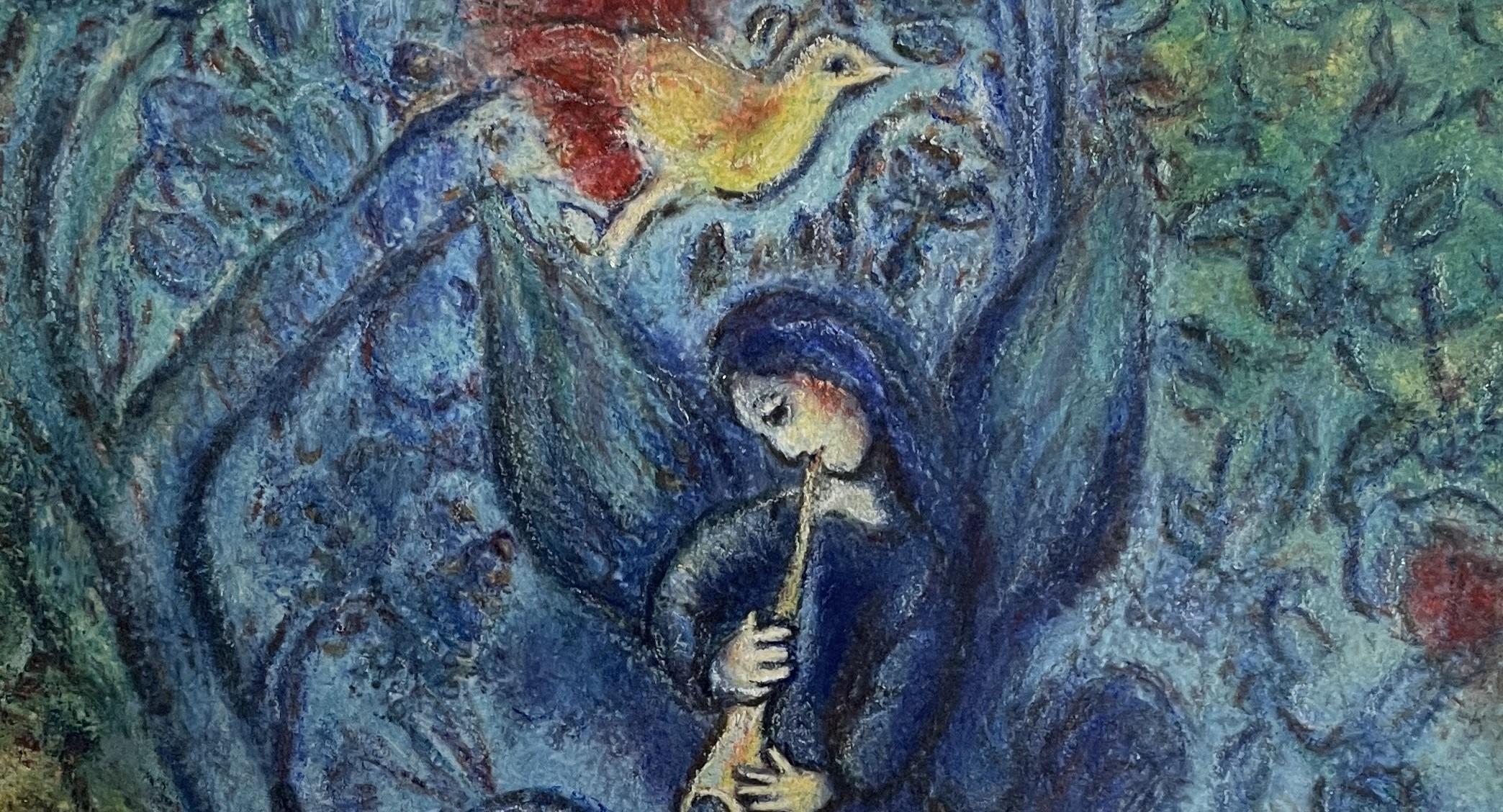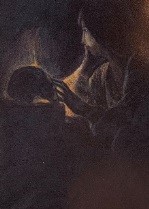日本語-Englishー台灣華語
ジョルジュ・ド・ラ・トゥール「悔悛するマグダラのマリア」
蝋燭の明りに照らし出されたラ・トゥールの作品は、静謐な美しさで観る者の心を温かく満たしてくれる。聖者は貧しい庶民の姿に描かれ、生身の人間としての尊厳に輝いている。17世紀フランスはカラヴァッチョの影響を受けることは少なかったが、ラ・トゥールは若い頃ローマを訪ね、カラヴァッジオの光の洗礼を受けたと言われている。ラ・トゥールは宗教的なテーマを神秘的に解釈した「夜」の連作を描いているが、ラ・トゥールの絵にある光は現実の光ではない。一つの意図を持って光と影を創り出している。そこにはカラヴァッジョの激情的な画面とは反対に、静かで思索に満ちた画面が生み出されている。彼が生きた17世紀は戦乱と飢餓と疫病に覆われた暗黒の時代であった。人々は深い漆黒の闇の中で死と孤独に絶えず怯えていた。ラ・トゥールの一筋の光には、苦しみから救われる深い精神的な安らぎが象徴されている。
数あるルーブル美術館の名画の中でも、ラ・トゥールが描いた「聖ヨセフと少年キリスト」は不思議な魅力を放っている。その絵では、大工のヨセフは黙々と夜なべ仕事に打ち込み、蝋燭を手にした少年キリストはその手許を一心に照らし、父を見つめている。二人の間に温かい時間が静かに流れて行く。しかしながらよく見るとヨセフが作っているのは、磔刑に使う十字架である。自分の子がいつか背負うことになる十字架を作る父親の運命が、この一本の蝋燭の照らし出す光と闇の構図に込められている。パン屋の息子であったラ・トゥールは、きっと小さい頃から親の仕事を手伝い、毎日窯の火を見詰めていたに違いない。その記憶を頼りに描かれた炎の中に浮かびあがる人物は、まるで自らの運命を暗示しているかのようだ。
ラ・トゥールはキリストを題材とした宗教画の中でもとりわけ「悔悛するマグダラのマリア」を様々なバリエーションで制作している。キリストと出会い悔悛したというマグダラ。マグダラは7つの悪霊(驕慢、強欲、淫乱、激怒、嫉妬、大食、怠惰)にとり憑かれた罪深い娼婦である。私が描いたマグダラは、ワシントンのナショナルギャラリーにある。ラ・トゥールの現存するマグダラの中でも闇の占める割合が多いものである。その分深い後悔が画面に滲みわたる印象を受けるが、ふと蝋燭の光に浮かびあがった女の横顔は、男を溺れさせる策略を巡らしているようにも思えてくる。瞳は未だに色香を漂わせて輝き、口は微かに開き微笑んでいる。じっと蝋燭を見詰めるこの絵は、悟りの瞬間を描いているという割には、まだ現世の快楽の名残が消えていないようにも見える。命のはかなさの象徴だと言われる骸骨さえも、マグダラの前に身を滅ぼした男の亡骸に見えてくる。随分若いと思っていた女は、よく観ると顎がかなり弛んでいる。若くして身を任せ、年齢の割には疲れを感じているのかもしれない。私の絵ではもう少し早くに悔い改められるように、少し顎をすっきりと描いてあげることにする。
ラ・トゥールはかなり複雑な性格の人であったと伝えられている。悔悛するマグダラのマリアは、聖なる火を前にして果たして本当は何を思っているのだろうか。魂の安らぎは、容易に達するものではなく、聖と俗をゆらめきながら、何年もかかってもたらされることを、この絵は語っているのかもしれない。ラ・トゥールの絵を眺めていると、ふとそんな事を考えてしまう。
神の導きによってラ・トゥールは画家となったが、同時に徴税官として極めて世俗的日常の中に生きた人物であることも判明している。富裕な特権層として民衆の怒りを買っていたとも言われている。そういえばラ・トゥールの絵には、宗教的聖画とともに、猜疑心や裏切りといった世俗的題材を描いた詐欺師や女占い師の絵がある。文字通り清濁合わせ持つ作品が残っている。ラ・トゥールは生前ルイ13世の宮廷画家にまで登り詰めたが、死後長らく忘れられてしまう。ルイ13世から太陽王と呼ばれたルイ14世に変わったフランスでは、絢爛豪華な芸術運動が盛り上がり、静寂で精神的なラ・トゥールの絵は時代の渦にかき消されてしまったのかもしれない。その絵は20世紀になってようやく再評価された。それもまた神の導きなのか。科学者のファラディーに蝋燭の炎から科学の本質に鋭く分け入って行く「蝋燭の科学」という有名な本があるが、ラ・トゥールの蝋燭の炎は、人の心を照らし出しながら、人間の本質が永遠の謎であることを問い掛けているのかもしれない。
Repentant Magdalen
The works of La Tour, illuminated by candlelight, warm the viewer’s heart with their serene beauty. Saints are depicted in the guise of poor commoners, shining with the dignity of flesh-and-blood humans. Although 17th-century France was little influenced by Caravaggio, it is said that La Tour visited Rome in his youth and received the baptism of Caravaggio’s light. La Tour has painted a series of “night” scenes that mystically interpret religious themes, but the light in La Tour’s paintings is not real light. It is created with a specific intention, generating a quiet, contemplative scene as opposed to Caravaggio’s passionate canvases. The 17th century in which he lived was a dark age covered with wars, famine, and plague. People constantly feared death and loneliness in the deep, pitch-black darkness. The single ray of light in La Tour’s work symbolizes profound spiritual relief from suffering.
Among the many masterpieces in the Louvre, “Saint Joseph and the Boy Jesus” by La Tour possesses a mysterious charm. In this painting, Joseph diligently works late into the night, while the Boy Jesus, holding a candle, intently illuminates his father’s work, gazing at him. A warm moment quietly flows between them. However, upon closer inspection, Joseph is making a cross to be used for crucifixion. The fate of a father making the cross that his son will one day bear is encapsulated in the composition of light and darkness illuminated by this single candle. La Tour, the son of a baker, must have helped with his parents’ work from a young age, staring daily into the furnace fire. The figures emerging from the flames he painted seem to hint at their own fate.
La Tour is particularly known for his various renditions of “The Penitent Magdalene,” depicting Magdalene who repented after meeting Christ. Magdalene, possessed by seven demons (pride, greed, lust, wrath, envy, gluttony, sloth), was a sinful prostitute. My depiction of Magdalene is in the National Gallery in Washington, one of La Tour’s existing works with a significant portion of darkness, giving the impression of deep remorse. Yet, the woman’s profile that suddenly emerges in the candlelight seems to be plotting to ensnare men. Her eyes still sparkle with allure, and her lips are slightly open, smiling. This painting, while supposed to depict a moment of enlightenment, still seems not to have fully shed the remnants of earthly pleasures. Even the skeleton, said to symbolize the fragility of life, appears to be the remains of a man destroyed before Magdalene. The woman, thought to be quite young, shows a noticeably slackened jaw upon closer inspection. Perhaps she has given herself too young and feels older than her years. In my painting, I decided to give her a slightly more defined jawline, allowing her to repent a bit earlier. La Tour is said to have had a complex personality. What, indeed, is The Penitent Magdalene truly thinking in front of the holy fire? Achieving peace of soul is not easy; it is brought about over years, wavering between the sacred and the secular, as this painting may suggest. Looking at La Tour’s paintings, one can’t help but ponder such thoughts.
La Tour became a painter by divine guidance but was also known to live a very secular daily life as a tax collector, even inciting the anger of the common people as a member of the affluent privileged class. Indeed, La Tour’s paintings include not only religious scenes but also secular themes such as suspicion and betrayal, depicting con artists and fortune-tellers. His work embodies both purity and corruption. La Tour, who rose to become a court painter for Louis XIII, was long forgotten after his death. In the transition from Louis XIII to the “Sun King” Louis XIV, France embraced a lavish art movement, and La Tour’s quiet, spiritual paintings may have been swallowed by the whirlwind of the era. His work was only reassessed in the 20th century. Perhaps that, too, was divine guidance. There is a famous book by the scientist Faraday, “The Chemical History of a Candle,” delving sharply into the essence of science from the flame of a candle. Similarly, La Tour’s candle flame, while illuminating the human heart, may also pose the eternal mystery of human nature.
喬治·德·拉·圖爾《悔改的抹大拉的瑪麗亞》
拉·圖爾的作品在蠟燭光照射下展現出的寧靜美,能溫暖觀賞者的心。聖者被描繪成貧窮的平民,散發著作為血肉之軀的尊嚴。17世紀法國受到卡拉瓦喬影響不多,但拉·圖爾年輕時訪問了羅馬,據說接受了卡拉瓦喬的光影洗禮。拉·圖爾畫了一系列以宗教主題神秘解釋的“夜”的作品,但拉·圖爾畫中的光並非現實中的光。他有意創造光與影。相對於卡拉瓦喬激情的畫面,拉·圖爾的作品則呈現出靜謐且充滿思索的畫面。他生活的17世紀是被戰亂、飢餓和疫病覆蓋的黑暗時代。人們在深沉的黑暗中不斷恐懼死亡和孤獨。拉·圖爾畫中的一縷光象徵著從苦難中獲得的深層精神慰藉。 在羅浮宮眾多名畫中,拉·圖爾的《聖約瑟夫與少年耶穌》散發著神秘的魅力。畫中,木匠約瑟夫埋頭苦幹,而手持蠟燭的少年耶穌則專注照亮他的工作,凝視著父親。兩人之間流淌著溫暖的時光。但細看之下,約瑟夫正在製作的是用於釘十字架的木架。這揭示了一個父親的命運,他正在為自己的兒子製作將來要背負的十字架。作為麵包師傅的兒子,拉·圖爾肯定從小就幫忙父母的工作,每天凝視著爐火。依靠這些記憶所繪製的火焰中浮現的人物,彷彿暗示著自己的命運。
拉·圖爾在以基督為主題的宗教畫中,特別是多次創作了各種版本的《悔改的抹大拉的瑪麗亞》。據說抹大拉在遇到基督後悔改了。抹大拉是一名被七個惡魔(驕傲、貪婪、淫欲、暴怒、嫉妒、暴食、懶惰)附身的罪深娼妓。我畫的抹大拉在華盛頓的國家美術館。拉·圖爾存世的抹大拉作品中,這幅畫的黑暗占比較多。因此,畫面給人一種深刻的後悔感,但偶爾蠟燭光下浮現的女性側臉,似乎還在策劃誘惑男人的計劃。她的眼睛仍散發著誘人的魅力,嘴唇微微張開,帶著微笑。這幅專注凝視蠟燭的畫,雖然被認為是描繪了悟的瞬間,但似乎還未完全擺脫現世的樂趣。甚至連被認為是生命脆弱象徵的骸骨,也讓人聯想到抹大拉面前自我毀滅的男性。原以為年輕的女性,仔細看卻發現下巴已相當鬆弛。或許她年輕時就過度放縱,比實際年齡顯得更加疲憊。我的畫中,我會讓她的下巴看起來更加緊致,希望她能更早悔改。拉·圖爾是一個相當複雜的人物。悔改的抹大拉的瑪麗亞在聖火前真的在想什麼呢?靈魂的平靜不是輕易達到的,這幅畫可能在說,即使經過多年,聖與俗的掙扎才能達到真正的安寧。看著拉·圖爾的畫,不禁讓人深思。
拉·圖爾因神的指引而成為畫家,但他也以稅務官的身份活在極其世俗的日常中。據說他作為富裕的特權階級,招致了民眾的憤怒。值得一提的是,拉·圖爾的畫中,除了宗教聖畫,還有描繪詐欺師和女占卜師等世俗主題的作品,真正體現了清濁並存。拉·圖爾生前曾成為路易十三的宮廷畫家,但死後長時間被遺忘。從路易十三到被稱為太陽王的路易十四的法國,繁華豪華的藝術運動興起,靜謐精神性的拉·圖爾畫作或許被時代所淹沒。直到20世紀,他的畫作才重新被評價。這也許是神的指引。就像科學家法拉第在《蠟燭的科學》一書中深入探討蠟燭火焰與科學本質,拉·圖爾的蠟燭火焰也許在照亮人心的同時,提問人性的永恆謎題。


